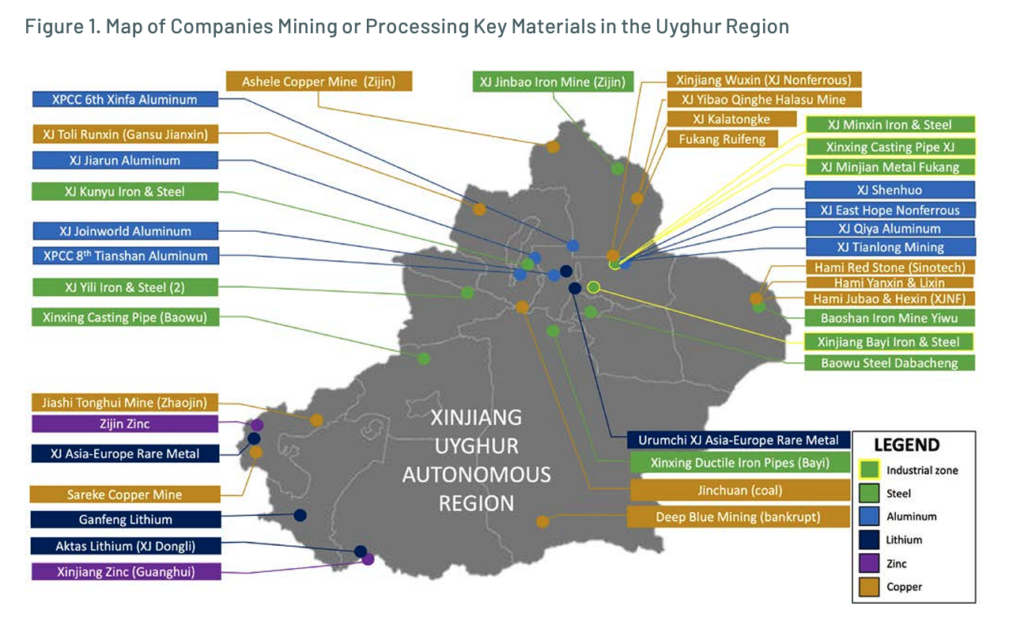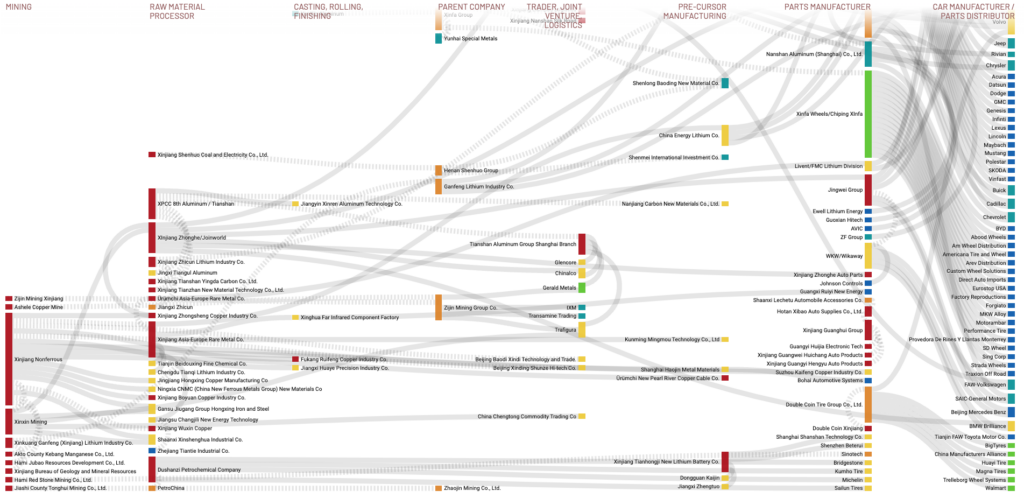Believe it or not, the car you’re driving around likely has parts made with forced labor. If you drive a car from Volkswagen-Audi, Honda, Ford, General Motors, Mercedes-Benz, Toyota, Tesla, Renault, NIO, or Stellantis—the parts in your car have a high risk of being sourced from companies linked to abuses in the Xinjiang Uygur Autonomous Region (XUAR) of China; the region targeted by the Uyghur Forced Labor Prevention Act, (UFLPA).
These findings come from a report published in December 2022 by a team of researchers at Sheffield Hallam University (SHU). The report, titled “Driving Force” investigates automotive supply chains and forced labor in the XUAR. According to the report, “…practically all parts of the car are exposed to Uyghur forced labor in one way or another.” This includes raw materials such as steel, aluminum, and copper, as well as automotive parts like hood decals, brakes, tires, seat cushions, batteries, electric components, and more.
Following the release of the report, the US Senate Finance Committee launched an investigation into major global automakers. In this blog, we will look at the report’s key findings and discuss the US Senate Finance Committee probe. Then, we will dive into what steps automakers can take to prove due diligence and build more resilient supply chains.
Highlights and Major Findings from the Report
China is one of the world’s largest auto parts suppliers—and it’s not by mistake. The automotive parts manufacturing market is expected to reach nearly US $2 trillion by 2026, and China wants a piece of the pie. China’s “Made in China 2025” plan prioritizes becoming “a world manufacturing power”, including the automotive and automotive parts industries.
The plan is working. In 2021, China exported over US $45 billion in auto parts—with the U.S. automotive industry receiving US $11.5 billion of those parts.

The success of this plan is mainly due to the XUAR. The Chinese government has incentivized companies to move raw materials processing (for materials such as iron and steel) to the XUAR, where regulations are loosely enforced. According to the report, a separate plan titled “Made in China 2025 Xinjiang Action Plan” repeatedly highlights “the government’s very specific ambitions to expand the automotive industry in the region and to make XUAR-based automotive parts brands into national and internationally recognized brands.”
As part of these efforts, China has placed millions of citizens from the XUAR into state-sponsored “labor transfer” programs. These programs coerce and force workers into labor-intensive industries under the constant threat of internment and imprisonment—comperable to modern-day slavery. The report’s key findings reflect the push towards the Uyghur region and the use of these “labor transfer” programs.
The report found that:
- 96 mining, processing, or manufacturing companies related to automotive operate in the region; At least 38 have documented engagement in state-sponsored labor transfer programs.
- 40+ automotive manufacturers in China source from the region or from companies that have accepted labor transfers.
- 50+ international auto parts or car manufacturers source directly from companies operating in the region or companies accepting labor transfers.
- 100+ international auto parts or car manufacturers have some exposure to forced Uyghur labor-made goods.

For a visual look at the automotive supply chain, check out this interactive network map from SHU to see how automakers are tied to the XUAR, from mining and raw materials, all the way to specific car manufacturers and parts distributors.
US Senate Finance Committee Probe into Forced Labor in the Automotive Industry
Following the release of this report, the Senate Finance Committee Chair, Ron Wyden, sent out letters to eight major automakers: Ford, General Motors, Honda, Mercedes-Benz, Stellantis, Tesla, Toyota, and Volkswagen. In these letters, Wyden stated, “Unless due diligence confirms that components are not linked to forced labor, automakers cannot and should not sell cars in the United States that include components mined or produced in Xinjiang.”
Wyden requested that automakers answer questions about supply chain mapping of raw materials, mining, processing, and parts manufacturing and answer whether or not the automakers had products detained by U.S. Customs and Border Protection under the Uyghur Forced Labor Prevention Act (UFLPA). Companies were asked to respond and provide information by January 13. According to the Senate Committee, the answers they received did not give enough details about how corporations oversee supply chains and ensure goods are not made with forced labor—with automakers often responding that suppliers were the ones responsible for ensuring forced labor was not used.
In March 2023, Wyden expanded the investigation, sending further questions to automakers and tier-1 suppliers. Wyden commented, “I recognize that tier-1 suppliers rely on complex supply chains to source thousands of parts from across the world. However, this complexity cannot cause the United States to compromise its fundamental commitment to upholding human rights and U.S. law.” The second round of letters went out to both the original eight automakers and several new tier-1 suppliers, including Continental AG, DENSO Corporation, Magna International Inc., Roberts Bosch GmbH, and ZF Friedrichshafen AG.
To learn more about the investigation, check out Resilinc’s special report, Leading Automakers Probed for Potential Ties to Forced Labor.
What Should Automakers Do About Forced Labor in the Automotive Supply Chain?
While these investigations are still underway as a part of the larger push to remove forced labor under UFLPA, what can car companies do to cease ties to forced labor? The report published by SHU gives several recommendations. First, car companies must map their supply chains for raw materials, mining, processing, and parts manufacturing in the XUAR—and not assume that any suppliers or sub-tier suppliers are free from links to forced labor. Car companies should adhere to the UN Guiding Principles on Business and Human Rights and prioritize identifying supply chain links to the XUAR.
If mapping reveals any ties to the region, companies should end contracts and relationships with those suppliers—and exit the XUAR at every level of their supply chain as soon as possible. To help facilitate transparency and knowledge sharing, companies should publicly report on findings of supply chain links to XUAR and publicly announce any decisions to terminate relationships. Finally, the report recommends that car companies should collaborate with raw metals industries to implement reparations to populations exploited in the XUAR.
Resilinc recommends that automakers assess if any Tier-1 suppliers are in the XUAR region. Then look carefully at the bill of materials for all merchandise, goods, and parts to see how deep the supply chain goes. Finally, gather documents from suppliers of all tiers regarding customs entry, documents for finished goods, proof of payment documents, and transportation documents.
If automakers aren’t sure where to start, Resilinc suggests looking for the following warning signs that suppliers may have ties to the XUAR:
- Operating within or near internment camps, prisons, or industrial parks
- High revenue with few employees paying into the government’s social security insurance
- Nonstandard hiring practices, such as hiring workers through government recruiters
How Resilinc Can Help Automakers and Parts Suppliers
Resilinc helps companies do their due diligence by providing deep visibility into the sourcing process. Using Resilinc’s Multi-Tier Mapping solution, automakers and suppliers can discover and map their suppliers’ supply chains down to the n-tier. Unlike other solutions, this comprehensive approach is powered by 12 years of supplier-validated data.
Next, Resilinc can help identify if any suppliers in an organization’s supply chain operate in the XUAR, if parent entities are based in the XUAR, or if any suppliers have been sanctioned. With this n-tier visibility, companies can then identify if any alternatives are available and vet those alternative suppliers. Automakers and automotive parts suppliers must figure out how to mitigate forced labor in their supply chains. The only way is to gain visibility through mapping.
To learn more about how Resilinc gives companies supply chain visibility, read more about Resilinc’s Multi-Tier Mapping.






